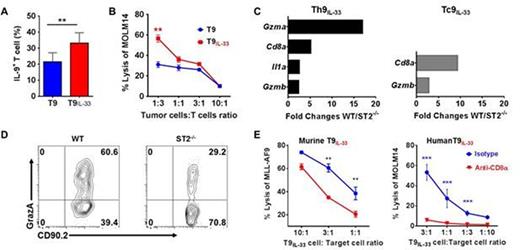Abstract
Treatment of acute myeloid leukemia (AML) has changed little over the last several decades and prognosis remains very poor. Allogeneic hematopoietic cell transplantation (allo-HCT) is one potentially curative option for relapsed or high-risk AML. The immunotherapeutic activity of allo-HCT is known as the graft-vs-leukemia (GVL) activity. However, GVL activity is often accompanied by T-cell reactivity to allo-antigens in normal host tissues, which leads to graft-versus-host disease (GVHD), another major cause of death after HCT with relapse. Therefore, there is a great unmet need to improve the current process of allo-HCT through increasing the GVL activity and decreasing GVHD. We have shown that an elevated plasma level of soluble (s)ST2 in HCT patients is a risk factor for severe GVHD (Vander Lugt et al, N Engl J Med, 2013) and that ST2 blockade reduces sST2-producing T cells while maintaining protective membrane (m)ST2-expressing T cells during GVHD (Zhang et al, Sci Transl Med, 2015). In addition, the interleukin (IL)-9-producing CD4 T helper (Th)9 and CD8 cytotoxic T (Tc)9 cell subsets (together T9 cells) have higher antitumor activity than Th1 and Tc1 cells in melanoma models (Lu et al, J Clin Invest, 2012 and Lu et al, ProcNatl Acad Sci, 2014). We hypothesized that activation of the ST2/IL-33 pathway in T9 cells will both alleviate GVHD and increase GVL. In our laboratory, we have shown that T9 cells express a high level of mST2 and that differentiation of total T cells into T9 cells in the presence of IL-33 (T9IL-33 cells) increases expression of mST2 (Figure 1A) and PU.1 (Figure 1B), a transcription factor that promotes IL-9 production on both CD4 and CD8 T cells. Adoptive transfer of T9IL-33 cells with bone marrow cells in a murine model of HCT resulted in less severe GVHD compared to transfer of T9IL33 cells generated from ST2-/- or IL-9-/- T cells (Figure 1C). Ex-vivo analysis of target organs such as gut showed a decrease in T9IL-33 interferon (IFN)g-producing T cells that was abolished in mice receiving T9IL-33 cells derived from ST2-/- or IL-9-/- T cells (not shown). Furthermore, T9IL-33 cells revealed higher anti-leukemic activity in vitro when cultured with a B cell lymphoma line (A20) or retrovirally transduced MLL-AF9 leukemic cells in cytolytic assays (not shown). In vivo GVL experiments with MLL-AF9 induced leukemia, and adoptive transfer of T9IL-33 cells resulted in increased survival compared to transfer of T9IL-33 cells generated from ST2-/- or IL-9-/- T cells (Figure 1D). Human T9 cells are poorly explored. We demonstrated that differentiation of human T9 cells in the presence of IL-33 enhanced IL-9 production by CD4 and CD8 T cells (Figure 2A). T9IL-33 cells also upregulated the expression of the cytolytic molecules granzymes A and B compared to T9 cells (Th9IL-33: 33.6%±4%, vs. Th9: 15.69%±2.53% p=0.021), (Tc9IL-33: 57.6%±4.7%, vs. Tc9: 34.61%±3.4% p=0.018), as well as demonstrated higher in vitro anti- leukemic cytolytic activity when incubated with MOLM14, an aggressive AML tumor cell line expressing FLT3/ITD mutations (Figure 2B). Transcriptome analysis of T9IL-33 cells from wild-type and ST2-/- T cells showed upregulation of molecules implicated in anti-leukemic activity (granzymes A and B, CD8α, IL-15, IL-15rα, IFNα, and IL-1α) on both CD4 and CD8 T cells (Figure 2C), and such upregulation was confirmed at the protein level (Figure 2D). Furthermore,investigations into the possible mechanism of activation using transwell assays revealed that both soluble factors and cell contact between Th9IL-33 and Tc9IL-33 T cells were required for maximum killing (not shown). We next investigated the possible mechanism of action and hypothesized that CD8α might be the contact-dependent component. CD8α blockade with neutralizing antibody during human T9IL-33 differentiation reduced the cytotoxicity of both murine T9IL-33 and human T9IL-33 cells (Figure 2E). Altogether, our observations suggest that adoptive transfer of T9IL-33 cells represents a promising cellular therapy following HCT.
Paczesny:Viracor laboratories: Patents & Royalties: "Methods of detection of graft-versus-host disease" (US- 13/573,766).
Author notes
Asterisk with author names denotes non-ASH members.



This feature is available to Subscribers Only
Sign In or Create an Account Close Modal